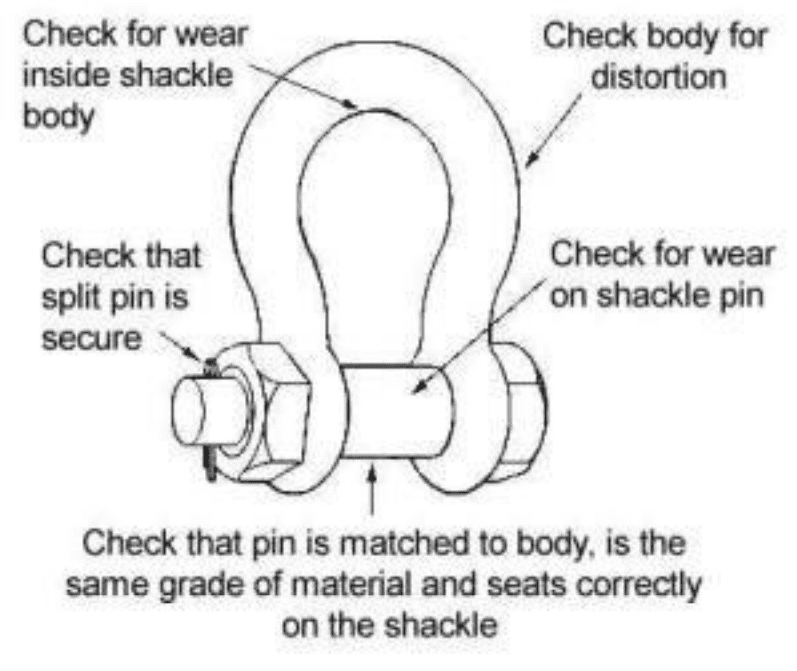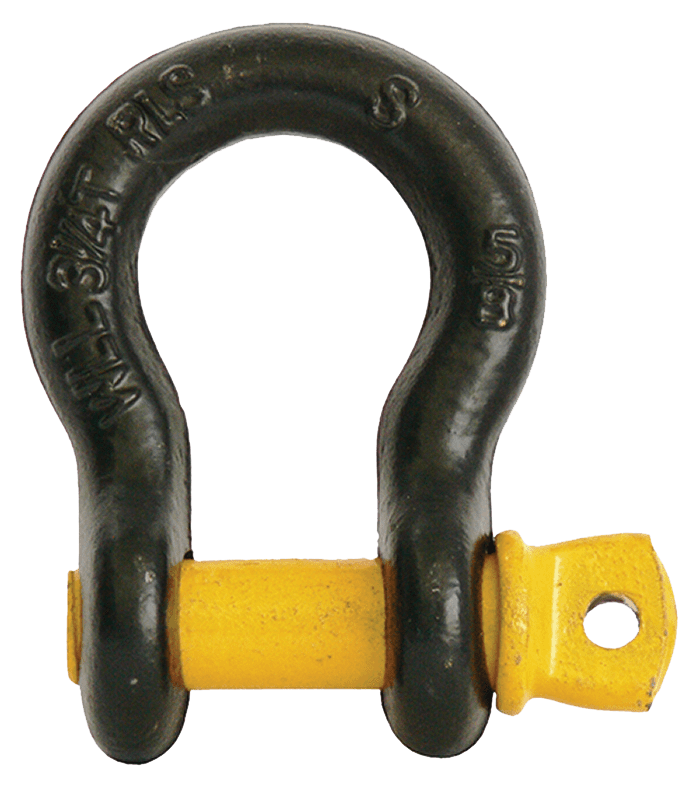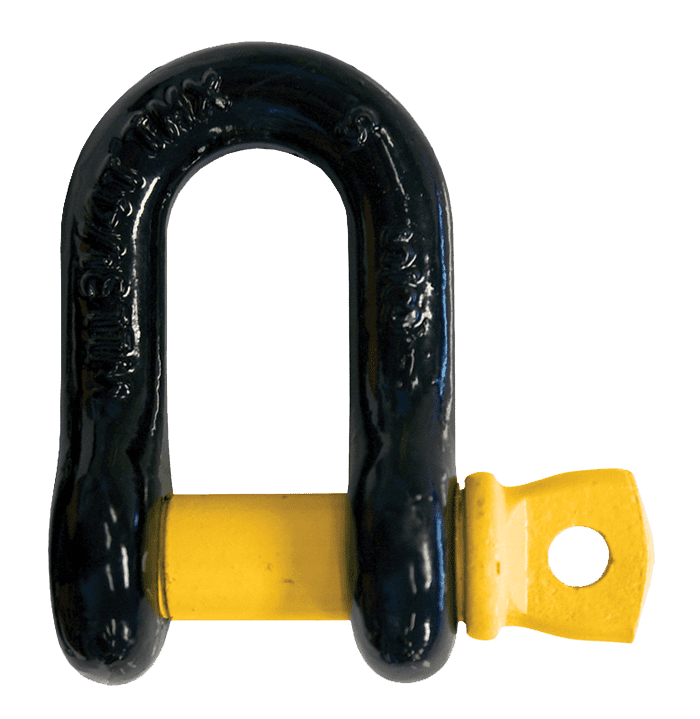At Outback Equipment, we stock bow shackles and D shackles. Our range of shackles are galvanised, S grade shackles with screw pins, mainly for the purpose of 4WD vehicle recovery or for connecting safety chains for towing your trailer/caravan. However, because there are so many shackles on the market it is a good idea to be familiar with the variations and what purpose the different design aspects of certain shackles serve. The other important thing to consider is your Working Load Limit (WLL). This is what will determine the correct shackle to use for your particular configuration.
The main types of shackles are ‘Bow Shackles’ and ‘D-Shackles’. The clear difference is the shape of each shackle.
- Bow shackles (also referred to as anchor shackles): Have a rounded body allowing for side loading and flexibility from different angles. A bow shackle is usually ideal in a recovery situation where the towing vehicle might have to come in from an angle other than straight on due to limited space. In general, bow shackles offer a greater range of movement with a better capacity for angular tension, which can also be good for trailer towing.
- D shackle (also referred to as a chain shackle): On the other hand, the straight body of a D shackle is designed for taking high loads through in-line tension. Placing side load tension on a D shackle may twist or bend its body. D shackles are generally used for single leg rigging and pulling applications — never multi-leg as this would distort the body and the pin.
Shackles will come with one of two different pins:
- Screw pins: Shackles with screw pins are used for non-permanent applications like vehicle recovery situations. They can be used in side-loading circumstances but keep in mind that reduced working load limits are required as the shackle’s Working Load Limit (WLL) is lessened the greater the angle of the side load.
- Safety pins: Shackles with safety pins are used for more permanent or long-term applications to provide a connection between machinery and chains or wire ropes. The design of the safety pin allows it to rotate without dislodging during loading conditions and where the load may slide. Safety pin shackles are good for standing up to machinery vibrations and are more commonly used in marine, agricultural, mining, and engineering industries.
There are three grades of shackles on the Australian market:
- S grade: This is the most common of the grades because of its higher strength and compatible sizing with like strength straps, chains, and wire ropes. The diameter size of the pin is also bigger than the diameter size of the body. Sometimes they will also have pins that are a different colour from the body. While the common belief is that this is an identifier of standards, it is in fact just a way for suppliers to differentiate themselves.
- M grade: Although stronger than mild steel, M grade shackles are not as strong or hard as S grade shackles. Like S grade shackles, the pin of an M grade shackle has a diameter greater than that of its body. M grade shackles are known for their superior ductility, or ability to change form under pressure without breaking. As such, they are commonly used in fishing industries where its high ductility is advantageous.
- Commercial grade: These are generally non-rated or non-marked shackles which are not recommended as their grade or WLL cannot be identified. A commercial grade shackle is also identified by having the same sized body diameter is its pin’s diameter.
Shackle Manufacture & Materials:
For applications such as lifting and vehicle recovery, a rated shackle forged from galvanised alloy steel is the strongest and safest option.
A forged shackle produces the same grade and density throughout the shackle when compared to the casting method. The process of creating a cast shackle allows for air bubbles to form and remain in the finished product, which compromises breaking strength. More likely than not, unmarked commercial shackles are produced from casting.
An ideal shackle will comply with Australian standards (AS 2741-2002) as this is outlines the requirements for manufacture, which include:
- Shackle body forging
- Dimensional specifications
- Correct ratios of material elements to create optimum strength and ductility
An Australian compliant shackle will have the right amount of carbon component, which makes it strong and hard but not so hard that it is becomes brittle and breaks without giving any prior indication. When overloaded, a good quality shackle should demonstrate stretching and distortion before it breaks.
Stainless steel is the other common material from which shackles are manufactured. These are usually used in the marine industry (M grade shackles) because they are less susceptible to corrosion and have a high ductility. Stainless steel shackles are not recommended for recovery situations as many people do not realise that they are using the incorrect size and are more likely to break as a result, potentially causing harm or death. Because of the varying grades of shackles, size does not necessarily correlate to strength. To get the equivalent strength of an S grade shackle, an M grade shackle must be bigger. This is why rated shackles should always be used and the Working Load Limit (WLL – see following) must always be checked to ensure the correct size is being used to your application.
When choosing a shackle the first thing you need to determine is how you will be using it as part of your configuration. While some activities can incorporate a shackle irrespective of its design, there are recommended applications for different shackle configurations. Because of safety and sometimes legal implications, shackles should always be used in the recommended manner.
Part of using a shackle within reasonable means is ensuring its Working Load Limit (WLL) is enough to support the task you intend to undertake. As a rule of thumb, the Maximum Proof Load should be about twice the WLL and the Minimum Ultimate Strength is 6 times the WLL. However, the WLL is the only rating that you should pay attention to and is usually the only one applied to a product.
For the purposes of towing a trailer, the way to determine which sized shackle you should use is by finding the WLL by using the following calculation:
(ATM × 1.5) ÷ 6 = required WLL of shackle
The Aggregate Trailer Mass (ATM) is determined by finding the total mass rating of your unhitched trailer (as specified by the manufacturer) and adding the recommended maximum load.
So for a trailer with an ATM of 2575kg the calculation would be:
(2575 × 1.5) ÷ 6 = 643.75
According to the following chart, the minimum WLL of a shackle appropriate for the stated application should be an 8mm S or 6 (or alternatively, a 13mm M or 4).
Using the calculation to find your required WLL, you can use the following chart to find the correct sized shackle.
| Diameter (mm) | WLL (kg) | Quality Grade Marking | Diameter (mm) | WLL (kg) | Quality Grade Marking |
| 6 | 250 | M or 4 | 16 | 1500 | M or 4 |
| 500 | S or 6 | 3200 | S or 6 | ||
| 8 | 750 | S or 6 | 19 | 2000 | M or 4 |
| 4700 | S or 6 | ||||
| 10 | 500 | M or 4 | 22 | 3000 | M or 4 |
| 1000 | S or 6 | 6500 | S or 6 | ||
| 11 | 1500 | S or 6 | 25 | 3800 | M or 4 |
| 8500 | S or 6 | ||||
| 13 | 750 | M or 4 | 29 | 5000 | M or 4 |
| 2000 | S or 6 | 9500 | S or 6 |
The following is a simplified guide that uses Aggregate Trailer Mass (ATM) to help select an appropriate shackle.
| ATM (kg) | Shackle Pin Size | Grade Markings | Alternative |
| Up to 4500 | 11mm | ‘S’ or ‘6’ | |
| Up to 4000 | 10mm | ‘S’ or ‘6’ | |
| Up to 3000 | 8mm | ‘S’ or ‘6’ | 13 mm ‘M’ or ‘4’ |
| Up to 2000 | 6mm | ‘S’ or ‘6’ | 10mm ‘M’ or ‘4’ |
| Up to 1000 | 6mm | ‘M’ or ‘4’ |
(Charts courtesy of RACQ)
Remember that your configuration is only as strong as your weakest point, so having a rated shackle that is the correct size and quality will ensure a sturdy and safe set-up.
Side loads should be avoided. If they cannot, always use a bow shackle and take the following reduction factors into account:
|
Load Angle |
Reduction for side loading (New WLL) |
|
0˚ |
100% of original WLL |
|
45˚ |
70% of original WLL |
|
90˚ |
50% of original WLL |
Most rated and marked shackles on the market will adhere to Australian Standard 2741-2002, however, it should be noted that this standard is only in relation to lifting equipment and not towing equipment. Legally, a shackle does not need to be marked but it is recommended that only equipment that is marked with its ratings should be used. If you can demonstrate that you have taken reasonable steps in using the correct shackle for its particular application, this may protect you under any negative circumstances that could occur.
Some tips for safely utilising shackles

- Inspect your shackles regularly — check for wear or damages. Ensure the pin and body are free from gouges, cracks, and corrosion
- Inspect the body for bending — a bent shackle indicates excessive side loading and should therefore not be used due to its weakened state
- If the pin is too difficult to turn, then the shackle may be overstressed and should not be used
- Never over-tighten a shackle pin — as a rule of thumb, turn the pin as far as it will go, then turn back to about half to a full turn, so the pin does not seize during lifting/recovery
- Try to avoid using a shackle in extreme temperatures as this will drastically reduce its WLL
- The colour of a shackle pin is related to the supplier to which it comes from and is not an identifier of standards
- Using folded, bunched, or pinched synthetic straps will reduce the rated load — a larger shackle may be required to support the width of the strap.
- Never modify, repair, or reshape a shackle as this will affect its WLL — simply replace if it is damaged or distorted
(Diagram courtesy of Nobles)




.png)